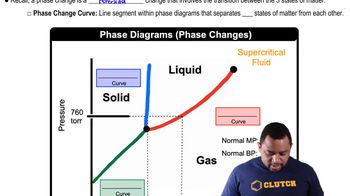The phase diagram for SO2 is shown here. (d) At which of the three points marked in red does SO2(g) most closely approach ideal-gas behavior?

 Verified step by step guidance
Verified step by step guidance
Verified Solution
Key Concepts
Ideal Gas Behavior

Phase Diagram

Critical Point

The following equilibria were measured at 823 K: CoO1s2 + H21g2 ΔCo1s2 + H2O1g2 Kc = 67 H21g2 + CO21g2 ΔCO1g2 + H2O1g2 Kc = 0.14 (a) Use these equilibria to calculate the equilibrium constant, Kc, for the reaction CoO1s2 + CO1g2ΔCo1s2 + CO21g2 at 823 K.
The following equilibria were measured at 823 K: CoO1s2 + H21g2 ΔCo1s2 + H2O1g2 Kc = 67 H21g2 + CO21g2 ΔCO1g2 + H2O1g2 Kc = 0.14 (d) If the reaction vessel from part (c) is heated to 823 K and allowed to come to equilibrium, how much CoO1s2 remains?
The phase diagram for SO2 is shown here. (e) At which of the three red points does SO2(g) behave least ideally?
In Section 11.5, we defined the vapor pressure of a liquid in terms of an equilibrium. (a) Write the equation representing the equilibrium between liquid water and water vapor and the corresponding expression for Kp.
